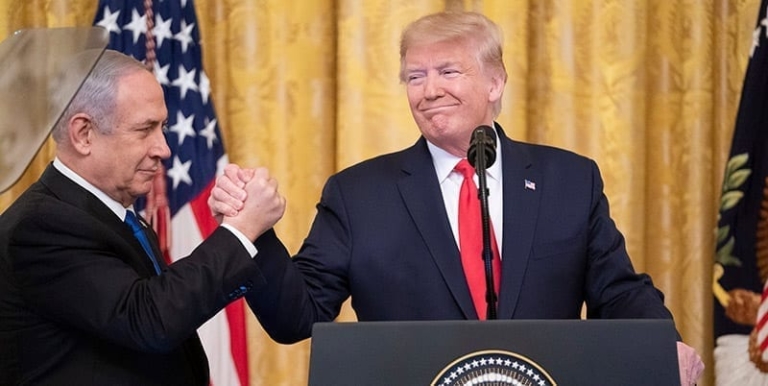
The day finally came. The long-awaited Trump Administration plan that would put forward a vision for Israel-Palestine was released yesterday. To say it was dead on arrival would be an understatement. Still, the announcement, the statements of the leaders themselves, and the contents of the plan are worth exploring to understand the full implications.
How Did We Get Here?
President Donald Trump’s systematic destruction of the Oslo Accords process—albeit seriously flawed—over the last several years preceded yesterday’s announcement. Since 2017, he has been dismantling the foundations of the moribund process by taking positions on issue after issue that were supposed to be resolved at the negotiating table. Each stand he took was the same as that of Israel. From recognition of Jerusalem as Israel’s capital, to his attack on Palestinian refugees, to the assault on Palestinian institutions and prisoners, to the recognition of Israeli sovereignty over the Golan Heights, Trump has managed to check every item on Israel’s wish list. Time and again, he has done so at sensitive moments in Israeli domestic politics, including the most recent announcement of his plan.
Trump has managed to check every item on Israel’s wish list. Time and again, he has done so at sensitive moments in Israeli domestic politics, including the most recent announcement of his plan.
Indeed, the display in the East Room of the White House also reflected a dynamic that has been ongoing in the US-Israel relationship since Trump took office: the symbiotic relationship between the US president and Israeli Prime Minister Benjamin Netanyahu’s domestic political needs. Each leader has been mired in scandal for years, with Netanyahu facing a host of indictments. Just before the announcement of Trump’s plan, Netanyahu was formally charged with a criminal indictment in an Israeli court on charges of bribery, fraud, and breach of trust. Trump himself is facing an impeachment trial in the US Senate at this very moment. Much like Nixon’s trip to the Middle East in 1974 at the height of the Watergate scandal, Trump is hoping the allure of peacemaking might change the conversation in Washington. While the announcement of Trump’s plan serves as a useful distraction from the unflattering news cycle each leader faces at home, the biggest benefit for them both is the way in which it helps reinforce the support of their respective bases.
Tag-Teaming Their Electorates
Not surprisingly, the Trump Administration’s actions and messaging on this issue have been put forward through the lens of religion and theology. For Trump’s base, many of whom are white evangelical Christians, unquestioned support for Israel is a rallying cry and a reminder of how committed the president has been to advancing their ideological world view. He continues to rely on this constituency while his presidency is in significant trouble. Standing alongside Trump, Netanyahu proclaimed, “You have been the greatest friend that Israel has ever had in the White House. Frankly, though we’ve had some great, outstanding friends in these halls, it’s not even close.” This indeed is music to the ears of the white evangelicals in Trump’s base.
For Netanyahu, the story is similar but somewhat distinct. Israel is having its third election this coming March in the course of about a year. The perpetual election cycle has helped Netanyahu stave off going to prison, at least for now, and electoral stalemates keep him in his position until a newly elected government can actually be formed. He is living on borrowed time and running out of political capital. But Trump has continued to swoop in to help him keep his head above water. Netanyahu’s coalition of right-wing religious nationalists has not been able to form a government on its own; but these Knesset members have been able to prevent a government from being formed, thus continuing the status quo. Keeping that coalition together, and enthused, has required Netanyahu to make the argument that he is able to deliver unprecedented goods for this constituency. With a partner in the White House ready to rubber-stamp his every settler-colonial dream, he has sufficiently kept his coalition intact.
Trump’s plan is but the latest iteration of this scheme and Netanyahu is planning to take further steps based on it to continue to please his extremist coalition. Standing beside Trump, Netanyahu announced that “Israel will apply its laws to the Jordan Valley, to all the Jewish communities in Judea and Samaria, and to other areas that your plan designates as part of Israel and which the United States has agreed to recognize as part of Israel.” Reports indicate that the Israeli government will vote on formally annexing about half of Area C of the West Bank to Israel this Sunday.
Reports indicate that the Israeli government will vote on formally annexing about half of Area C of the West Bank to Israel this Sunday.
Trump, in his remarks, committed that the “United States will recognize Israeli sovereignty over the territory that my vision provides to be part of the State of Israel.” He then added, “Very important.”
Very important, indeed. Since the start of the Trump presidency, the Israelis have sought to exploit the opportunity to the fullest extent. They had pursued these unimaginable concessions previously but always failed; with Trump, such appeals became possible. Even if a future administration wants to take a different position from Trump’s, the realities the Israelis could create on the ground would only move the goalposts farther to the right.
The Announced “Plan” and the Real Plan
So what is in the plan itself? The White House bills the plan as a “realistic two-state solution,” but it proceeds to explain in detail an outcome that is neither realistic nor involving two states. Instead, it presents a map of Palestinian Bantustans—a Swiss cheese-like entity connected by tunnels and bridges. Israel, it says, would retain “overriding security responsibility for land west of the Jordan River.” So there is transparently no independence or sovereignty or even a state here, other than that of the state of Israel.
Territorially, the plan gives some 30 percent of the West Bank to Israel, which apparently can be annexed and will be recognized by Israel right away. But that is not the whole story. The tiny, disconnected, debilitated, and utterly dependent entity masquerading under the title of a Palestinian state is something the Palestinians can only aspire to in this plan. They have to earn it based on good behavior and by satisfying a series of Israeli preconditions. What this plan boils down to encapsulates all of the worst aspects of the Oslo framework for the Palestinians; even worse, it offers them even less and comes nearly three decades later.
It is important, however, not to get too bogged down with the details of this plan since it is not only a nonstarter but is actually designed to be that way. That is what the real plan seems to be. Forget the words committed to paper. The message it sends to Palestinians is that the Americans and the Israelis are hoping for them to reject it—as anyone offered a deceitful insult would do the same—so the Israelis could go on with their ever-accelerating colonial project and claim that the Palestinians missed another opportunity.
More than ever before, the idea of a two-state solution has become a farce and it will ultimately force Israel and the world to either accept a Jewish apartheid state or demand a government based on equal rights for all. Much like Netanyahu facing indictment or Trump facing impeachment, Zionism is living on borrowed time and the plan on display here is an attempt to put off, once again, the expiration date of a harmful ideology that has led to decades of incalculable death, injury, and suffering between the Jordan River and the Mediterranean Sea.
This plan was anticipated for several years and now Netanyahu has finally played his most important Trump card. The questions that remain are about how the international community and the Palestinians respond.
This plan was anticipated for several years and now Netanyahu has finally played his most important Trump card. The questions that remain are about how the international community and the Palestinians respond. For the international community, it might be tempting and convenient to sum this all up as yet another one of Trump’s crazy antics that could be reversed by his successor. But this approach would be complicated once the Israelis begin acting on the vision––perhaps as early as this week. What will the European reaction be, for example, once the Israelis annex Area C? What will be the reaction of the United Nations?
Perhaps more importantly is the response from Palestinians. Three years ago, in May 2017, Palestinian President Mahmoud Abbas met with Donald Trump. As the two leaders spoke at the White House, months before Trump’s Jerusalem decision, Abbas concluded his comments with the following words: “Mr. President, I believe that we are capable under your leadership and your stewardship to—your courageous stewardship and your wisdom, as well as your great negotiating ability, I believe, with the grace of God and with all of your effort—we believe that we can be partners, true partners, to you to bring about a historic peace treaty under your stewardship to bring about peace. Now, Mr. President, with you we have hope.”
To avoid appearing hopeless, Palestinian leaders will have to provide an alternative path forward. They will be under pressure to present a different strategy for their people—or get out of the way. Today, Abbas rejected Trump’s plan, but the plan itself is the culmination of a path the Palestinian leadership willingly pursued and still has not determined it would abandon. Trump and Netanyahu might be a pair of crooks, but it is the Palestinian people who are being robbed of their freedom and dignity every day. It is long past time for Palestinian leaders to fundamentally recalculate their strategy.

